10 Wild Edible Plants
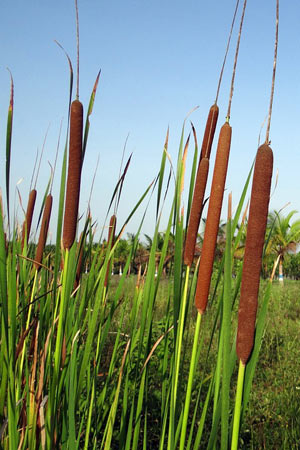
Here are some common wild edible plants with pictures. For more detail about each edible wild plant and others that I don’t talk about here, use the links to that specific wild edible plant. Note that a lot of the plants I have here are really edible weeds so you can often find them in the city and suburbs!
One of my favorite people and author is Thomas J. Elpel and he has a great book on edible plants that you can read about here.
Milkweed: Wild Edible Plants #1
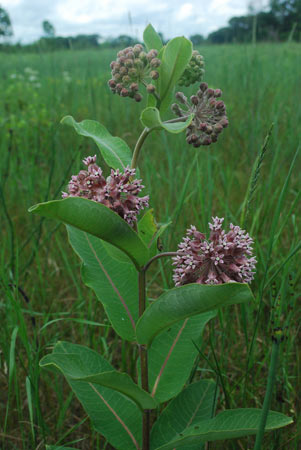
Milkweed is a great plant because you can eat something on it during most of its growing season. In the early spring you can eat the shoots. Later in the spring and summer the top 4 or 6 leaves are great – almost as good as the shoots. Moving into spring and summer the young flower buds and purple flowers are there for the picking. And finally, in later summer you can eat the young seed pods.
As you gather milkweed through the growing season, you’ll find you can harvest more than one part of the plant at the same time. I’m writing this article in late-July in Wisconsin, and I gathered all the edible parts of milkweed except for the young shoots!
A lot of people have been told that you need to boil milkweed in 2-3 changes of water to make it edible, but that’s not true at all. I eat it raw with no problems, though I have an iron stomach and have been eating it for years.
All you need to do to make a great side dish out of any of the plant parts I mentioned above is to steam, boil or fry them. I prefer the flowers and young seedpods fried in olive oil. They are even better if you dip them in egg, then coat them with whole wheat flour before you fry them into fritters.
I also boil, or really it’s more like steaming, the shoots and top 4-6 leaves. All you need to do is add a bit of water to a pan with these veggies and let the boiling and steam cook the milkweed. They are done when the leaves are a dark green and the white sap disappears from the cut parts of the plant.
Nettles: Edible Wild Plants #2
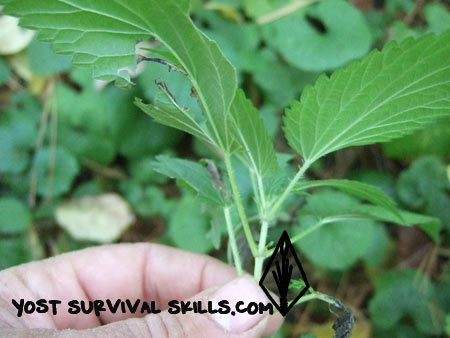
I have a blog post on eating nettles here.
Nettles are an amazing edible plant. Even people who don’t like to “eat weeds” usually love nettles. They are similar in taste and texture to spinach, except nettles are much more nutritious.
The only tricky thing about gathering stinging nettles is that they sting you… duh. You can wear gloves and that works okay, but if your hands are calloused, you might be able to pick nettles with your bare hands. My hands have decent callouses, and I only get stung on the backs of my hands if I’m careless or reaching into a thicket of nettles.
You can enjoy nettles from when they first pop up in the spring until well into august. What you’re after are the youngest leaves of the plant. So, you can either harvest the young shoots or nip off the top 4-6 leaves as the plant grows. One great thing about nettles is that if you harvest the tops of the plants early in the year, lots and lots of new leaves will grow above each leaf pair on the main stalk. These new leaves are available all season long and are really tender!
I cook nettles by putting just a bit of water in a pan, then adding olive oil. I cover the pan at first. What I want is for the water to boil and sort of steam the nettles at the beginning of the cooking process. Then I take the cover off to let the water evaporate and then the nettles fry in the oil. This makes a fast, delicious side dish. This is also a great way to cook milkweed.
The other way to cook nettles is to simply steam or boil them until they are a dark, rich green color. They cook down to less than half of what you started with, so gather more than you think you’ll need. I usually harvest about two bowls full for a generous helping when I’m out by myself.
More on eating nettles from yostsurvivalskills.
Cattail: Edible Wild Plants #3
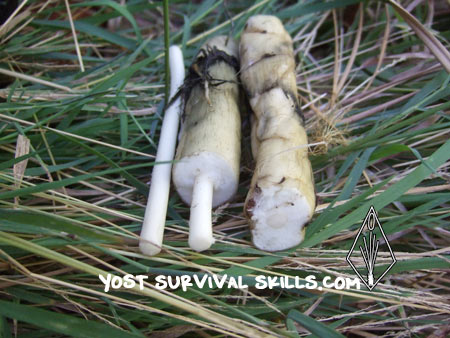
There is something edible on a cattail no matter when you’re gathering it. This plant is an amazing edible! In the spring the young shoots and small corms can be eaten raw or boiled. Both are delicious. The shoots taste like asparagus to some people. The corms are full of starch and absolutely delicious.
You can gather the male flower heads while they are still enclosed in the leaves, and when they are just poking out. These are great, you prepare and eat them just like corn on the cob.
A bit later in the year, the pollen can be gathered by bending the stalks over and shaking them into bags. The yellow pollen is high in protein and is great for thickening soups. The pollen also makes a delicious coating for milkweed flower fritters or batter fried fish.
In the fall and winter you can gather the roots for their high carbohydrate content. You want to save just the core of the roots and leave the spongy stuff behind. Once you’ve separated the middle, you crush them and let the starch filter out. Or, you can dry and grind the roots. Both of these methods are too much trouble for me so what I do is boil the root cores in water and chew them like gum to get the starch out. Then I spit out the fiber that’s leftover. Then I use the water the cattail roots boiled in for a soup stock.
Blackberries: Wild Edible Plants #4
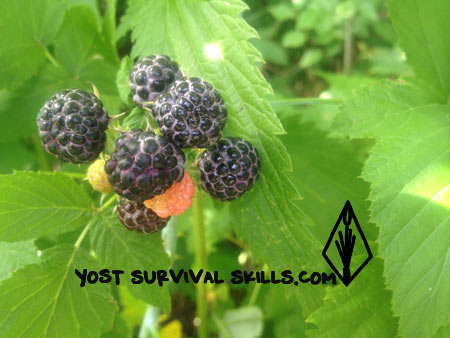
Blackberries, blackcaps, raspberries and the like are delicious eaten right off the bush. There’s really not much to say about these berries, just pick and eat them on the spot.
Though one great and somewhat unique quality of these berries is that it’s easy to preserve them. You can simply dry the entire berry on flat rocks. Or, if you have parchment paper, tin foil, or even a black plastic trash bag, you can crush the berries and dry them into fruit leather. The fruit leather is really good and if I’m at home with any of these berries, I’ll use my VitaMix to puree the berries and add a little sugar before making the fruit leather.
Lamb’s Quarters: Edible Wild Plants #5
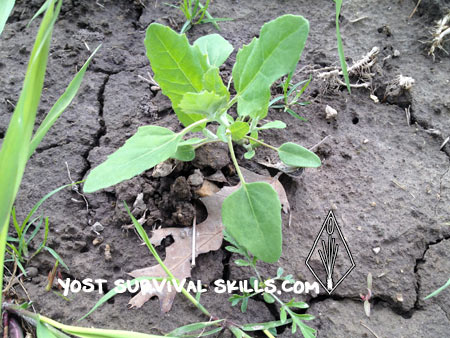
Lamb’s quarters are common in parks and lawns and most people consider them weeds. Which I suppose they are, but they’re a great wild edible none-the-less.
Lamb’s quarters is in the genus Chenopodium and in my travels across the world I’ve found that people everywhere eat the local species. Once you learn how to identify this plant, you can find and eat it just about anywhere you go.
The top 4-6 leaves on lamb’s quarters is a great addition to a pot of greens or as a standalone dish. They have a sort of grittiness that disappears when you cook them.
I prepare lamb’s quarters exactly the same way as nettles. Lamb’s quarters doesn’t boil down as much as nettles do so you don’t have to gather as much as when collecting nettles.
You can also eat the seeds from lamb’s quarters. They are pretty easy to collect by just shaking the mature seeds into a paper bag. A lot of people mess around separating the seed from the chaff, but I don’t. If I’m at home, I’ll blend whatever is in the bag (minus the bugs) in my VitaMix and freeze it to use as a substitute for flour. If I’m out in the woods, I’ll just make a boiled cereal out of the fresh seeds.
Oaks: Wild Edible Plants #6
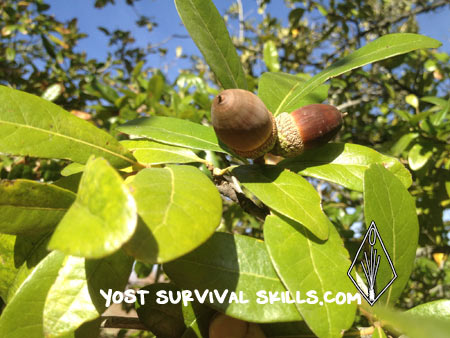
Oak trees provide acorns, and acorns are your best friend if you’re looking to harvest food in the wilderness. Not just for the plant itself, but for the animals that come to eat the acorns. Deer, squirrels, and raccoons love acorns and those mammals are edible too. If you need meat, it’s not a bad idea to look near an oak tree.
But, this article is about plant food, and what we want from the oak tree is the flour that comes from the acorns. There are lots of differing opinions on how to process acorns for making flour and how you do it depends on how bitter the acorns are.
Your goal is to leach the tannic acid, which causes the bitterness out of the nutmeats. You can either boil the acorns in changes of water until they are palatable. Or you can submerge the acorns in clean, running water until the tannic acid is gone. Either way, you are going to want to crush the acorns. At home I use my VitaMix. If I’m out on a survival stay, I crush them using two rocks like a mortar and pestle. You want to grind the acorns as fine as you can without losing any through the holes in whatever you’re putting in the creek.
Once you have the tannic acid out of the acorns, you do a final grinding 9or VitaMixing) to powder the acorns. Then you lay them out to dry. Acorn flour is prone to getting infested with bugs whether you’re out in the woods or at home. so at home I put mine in the freezer, in the wilderness, I use it right away or store it in some kind of bug proof container.
Prickly Pear Cactus: Edible Wild Plants #7
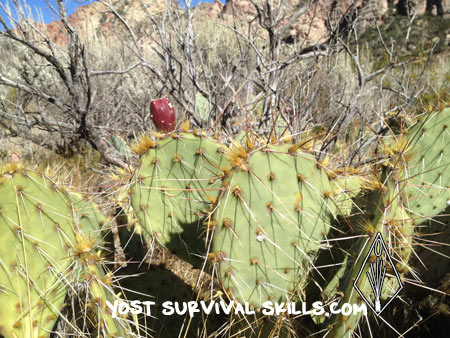
Prickly pear cactus was the first wild edible plant I ate when I moved out west. The purplish red fruit is absolutely delicious. It tastes like no other fruit I’ve ever had, a cross between strawberries and mango.
The fruit ripens from mid-summer through fall depending on the local climate and you can often search around in an area to find ripe fruit somewhere. I look for ones that have fallen to the ground because those are always the sweetest fruit. But, you can pick them off the top of the leaves too.
The only problem with prickly pear fruit is that they have tiny, almost invisible, sticker in them called glochids. You want to get these little buggers out of the fruit before you bite in, or you’ll get a mouthful of microscopic spines that take days to get out.
The best way I’ve found to remove the glochids is to cut around them with a knife. Some people burn them off, but I must not do a good enough job of it because every time I’ve tried burning them, I miss some and get stuck.
The fruit can be eaten raw, and is probably best that way. But, if you want to store food for later, prickly pear fruit is a great food to preserve for later. All you have to do is remove the seeds and dry the fruit in the sun. Preserving them couldn’t be easier.
The other edible part of the prickly pear cactus is the young pad. You can tell which pads are young because the spines on them are either nonexistent or soft. If there are spines on the cactus leaves, you can just cut them out. then peel the cactus so you’re left with the meat on the inside. This can be cut up into quarter inch square pieces and used as a side dish or added to soups and stews. Prickly pear leaves are slimy, kinda the consistency of okra, and they add a nice texture to soups but are hard for me to eat on their own.
Mulberries: Wild Edible Plants #8
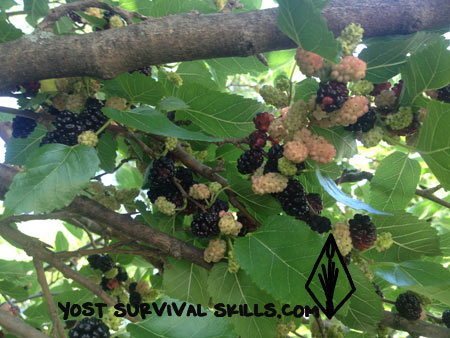
Mulberries don’t grow all over the United States, but I had to include them here for a few reasons. One, they are by far my favorite berry. Two, you can gather a TON of them from one tree. And three, not many people know you can eat them.
The reason we don’t see them in the stores like strawberries, dewberries and raspberries is that mulberries don’t ripen at the same time. That makes them hard to harvest commercially, but GREAT for wild foragers like us. Some years you can get a quart of mulberries every day for two or three weeks running and never get sick of them. they are that good.
Mulberries also make great jams and spreads that you can make in the woods if you have sugar. I made my first batch of spread this year and it kept for over 3 weeks with no refrigeration.
Other ways to preserve mulberries are the same as the other berries I mention in the blackberry section above. You can crush them and dry them into leather. And you can dry them whole if you have a couple of days of hot sun or a dehydrator.
Manzanita: Edible Wild Plants #9
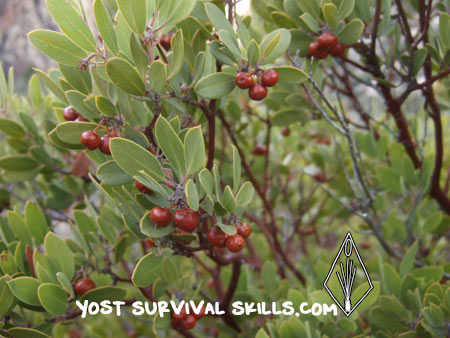
Manzanita is one of my favorite wild edible plants of the west. It grows where not many other trailside edible live, so it’s a welcome treat when you find it, nibbling as you go. The berries from different plants mature at different times so with a little searching you can usually find a plant chock full of berries.
Also, manzanita berries sometimes dry on the plant instead of dropping to the ground so they are easy to gather pre-preserved!
The berries have a big seed in them and it’s tedious to try to take them out to make fruit leather. Mushing them around in your mouth is the easiest way to get the fruit off the seed and is pleasant enough to do as you sit and chat or walk along the trail.
Curly Dock: Wild Edible Plants #10
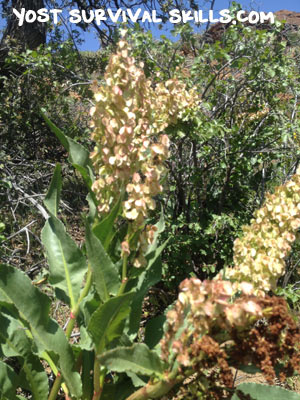
Dock isn’t the best wild edible plant on this list, it turns an ugly brown color when cooked and it tends to be a bit fibrous. But that fiber is great for scraping out your insides. When dock is mixed with other greens, it adds a subtle lemony flavor to the whole pot.
I cook dock the same way I cook nettles. I add a little water and some oil then cook it covered until it’s well steamed. Then I take the cover off and let the water boil away as the dock fries in the oil. Great stuff!
Dock cooks fairly quickly and doesn’t lose much volume, so it’s great if you’re hungry and don’t have a lot of time to forage.
